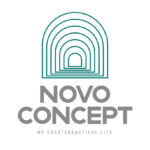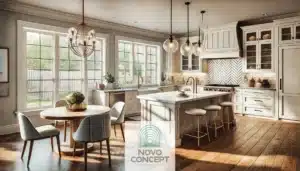Building a modern, energy-efficient home combines the dream of stylish living with the practical benefits of lower utility costs and sustainability. Achieving this on a budget requires a balance between innovative design, energy-conscious features, and cost-saving strategies. Here’s how you can create your ideal home without breaking the bank:
1. Define Your Priorities and Budget
The first step to building your dream home is clarity. Determine what you value most in a home—energy efficiency, aesthetics, or functionality. Once you have a clear vision, align it with your budget.
Key Questions to Ask Yourself:
- What energy-efficient features are non-negotiable?
- Are there design elements you can adjust to save costs?
- How much can you comfortably spend, including a buffer for unexpected expenses?
For example, if energy savings are your top priority, focus on features like solar panels, efficient HVAC systems, and proper insulation. However, if modern aesthetics take precedence, consider allocating more for sleek finishes while adopting cost-effective energy solutions.
2. Plan Ahead with Precision
Proper planning is the backbone of any successful construction project. Begin by working with an architect or designer familiar with energy-efficient construction. Detailed blueprints can save you from costly revisions later and it’s important step in Building a modern home.
Benefits of Meticulous Planning:
- Avoiding costly design changes mid-project
- Optimizing the layout for natural light and airflow
- Ensuring all materials and technologies meet energy-efficiency goals
Pro Tip:
Incorporate passive solar design into your plans. Strategically position windows and living spaces to maximize natural heating and cooling, reducing energy consumption.
3. Set Aside a Flexibility Fund
Even with the best planning, surprises happen. From unexpected site conditions to fluctuating material prices, having a contingency fund is essential. Experts recommend allocating at least 10–15% of your total budget for unforeseen expenses.
Common Unplanned Expenses:
- Adjustments due to local building codes
- Material shortages or delays
- Upgrades to essential systems, like plumbing or electrical
Being prepared for these costs can prevent delays and keep your project on track.
4. Choose the Right Energy-Efficient Features
Investing in energy-efficient systems and materials pays off in long-term savings. Prioritize features that deliver the best return on investment while reducing your environmental footprint.
Must-Have Energy-Efficient Features:
- Solar Panels: Generate renewable energy and cut utility bills.
- High-Performance Insulation: Keep your home comfortable year-round.
- Energy-Efficient Windows: Reduce heat loss and improve natural lighting.
- Smart Thermostats: Optimize heating and cooling with minimal effort.
Budget Tip:
Look into tax credits and incentives for energy-efficient upgrades. Many governments offer programs that can significantly offset initial costs.
5. Select the Right Builder
Your choice of builder will make or break your project. Look for a contractor with experience in modern, energy-efficient homes. Review their portfolio and verify references to ensure they deliver quality work.
What to Look for in a Builder:
- Familiarity with energy-efficient technologies
- Transparency in pricing and timelines
- Strong communication skills
- Positive reviews and recommendations
Pro Tip:
Ask your builder about their approach to sustainable construction. Do they source eco-friendly materials? Are they up-to-date with the latest green building practices?
6. Ask Smart Questions Before Construction Begins
Preparation is key to avoiding costly surprises. Discuss every detail with your builder before starting construction.
Questions to Ask Your Builder:Modern home building
- How do you ensure the home meets energy-efficiency standards?
- What’s included in the base price versus add-ons?
- What are the timelines, and how do you handle delays?
- Can I make changes during construction without significant costs?
Clear communication early on can prevent misunderstandings and ensure your vision is realized.
7. Maintain Open Communication
Construction is a dynamic process, and staying involved can help keep everything on track. Regular check-ins with your builder ensure alignment on progress and quality.
Ways to Stay Engaged:
- Schedule weekly updates or site visits.
- Use project management apps to track milestones.
- Keep records of all agreements and changes.
Key Benefits of Regular Communication:
- Faster resolution of issues
- Better alignment with your expectations
- A smoother overall construction experience
8. Incorporate Modern Design on a Budget
Modern homes are known for clean lines, open spaces, and functional layouts. Achieving this aesthetic doesn’t have to break the bank.
Cost-Effective Modern Design Ideas:
- Open Floor Plans: Create a spacious feel without adding square footage.
- Minimalist Finishes: Choose sleek yet affordable materials like polished concrete or laminate.
- DIY Decor: Add personal touches with budget-friendly projects.
9. Maximize Energy Efficiency with Smart Technology
Smart home systems enhance energy efficiency while adding convenience. Integrate devices that help monitor and control energy use.
Top Smart Home Technologies:
- Smart Lighting: Use motion sensors and timers to reduce electricity waste.
- Energy Monitoring Systems: Track usage and identify areas for improvement.
- Smart Appliances: Opt for Energy Star-rated models that use less power.
10. Embrace Sustainability Beyond Construction
Your commitment to sustainability doesn’t end once your home is built. Adopt eco-friendly habits to minimize your ongoing impact on the environment.
Sustainable Practices for Everyday Living:
- Use rainwater harvesting systems.
- Compost kitchen waste for gardening.
- Opt for LED lighting throughout the home.
Conclusion
Building a modern home, energy-efficient home on a budget is entirely achievable with the right strategies. By defining your priorities, planning meticulously, and choosing energy-saving features, you can create a home that’s stylish, functional, and kind to the planet.
Contact us at Novo Concept Take the first step today, and turn your dream of sustainable living into reality!






